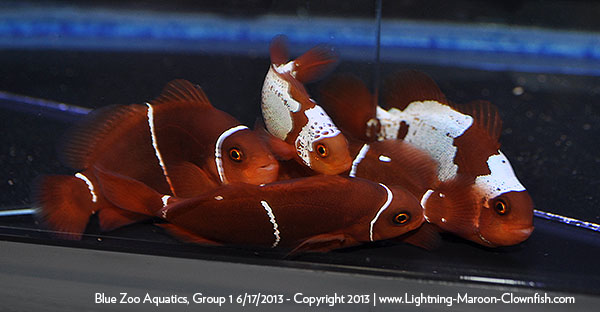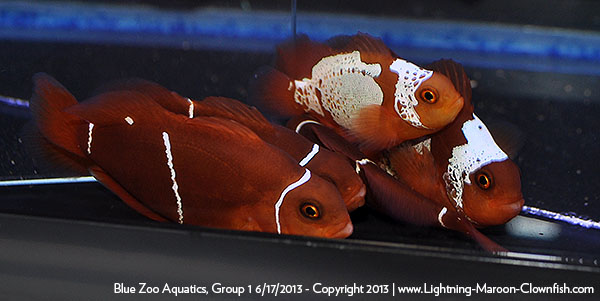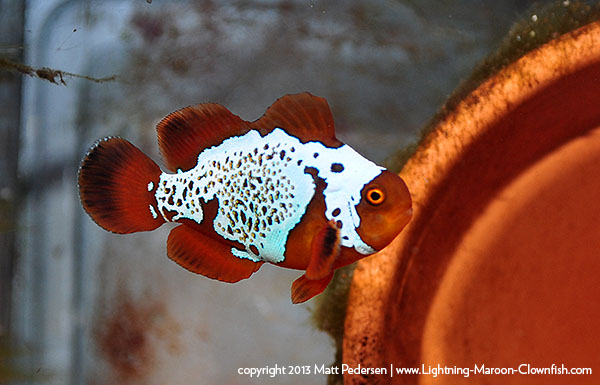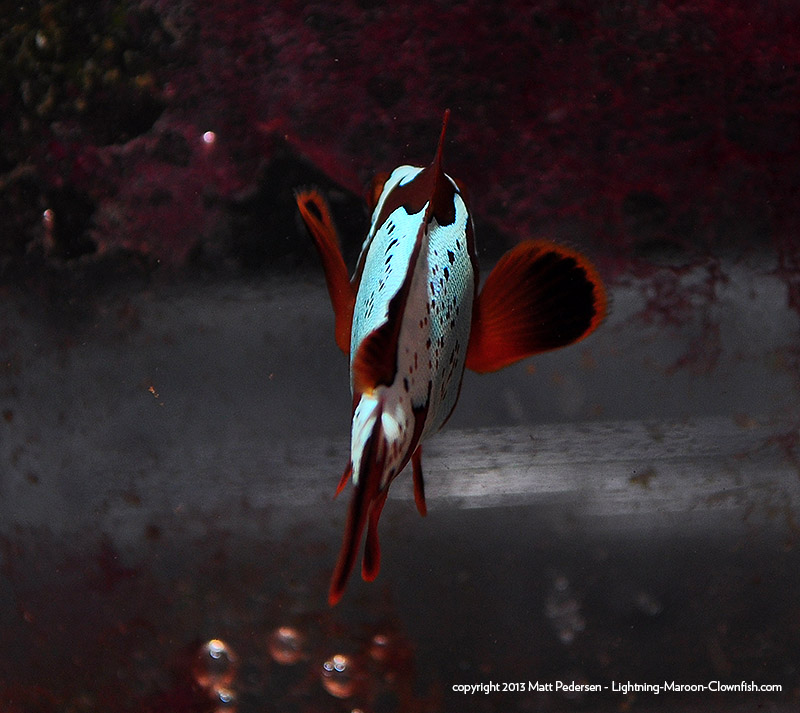The first retail offerings of Lightning Maroon Clownfish are only days or weeks away!

One of the two mystery destinations for today’s Lightning Maroon shipments is indeed Blue Zoo Aquatics. If you’ve been paying attention to their newsletters, or to Reef Builders, this should come as no surprise. Way back when starting this project, I made the unilateral offer that I would provide Blue Zoo Aquatics with the right of first refusal on these fish, and of course, they’ve accepted my offers. I’m excited about the introduction of these fish to the masses.

Initially, the plan is to offer these F1 PNG Maroons in public, WYSIWYG auctions via eBay. Everyone will have a fair shot at them. This way the market truly sets the price..no one will be able to accuse us of “gouging”. We’re playing no favorites either; initially I we had discussed holding back the lesser quality fish (some of which normally would be culled) to provide them to commercial breeders in private auctions. I suspect some fish will go surprisingly inexpensively, while others may fetch a handsome sum. We have no set time limit as to when these auctions will occur, but with the F1 fish now close to a year old and getting quite large, as we start pulling from the group tank, we may have to move quickly to prevent murders etc. We had also planned to drop ship the fish directly from Duluth, MN, but that plan has changed too.

Like all good plans, the simple logistics of running what is probably the 2nd largest online retailer of marine livestock, combined with delays this winter, followed by the arrival of my new daughter, caused Mark Martin and I to reexamine some of our more detailed plans, ultimately streamlining things a bit for me and giving Blue Zoo a little more hands on control in fulfillment of winner’s purchases. These first 5 will be our test scenario, and if it goes well, you can probably expect most or all of the Lightnings I sell to be offered through Blue Zoo Aquatics.

In the process of shooting photos and bagging today, I photographed all of the F1 PNG offspring individually to create an “inventory” of sorts; each fish will be posted individually going forward, which will allow for individual reference. Some of the general white stripe offspring might be difficult to differentiate, but the Lightnings by and large should be easy enough to follow as they leave here and go through the sales process.

The main reason for shooting ALL fish that I currently am considering for sale is this – I don’t want anyone thinking that we held out and sold the “worst fish” first. Nor do I want folks thinking there is an endless supply – there isn’t. The one spawn that produced babies this spring gave me TWO FISH that are smaller than my pinky fingernail…I still have my work cut out for me with the wild pair. Now, not every fish that I post up will necessarily be sold, and there may be some surprises if I opt to release other fish I’ve currently earmarked to hold onto personally for for other special projects. Bottom line, it’s not 100%…but it’s going to be a pretty good idea of what’s likely to come.
How to get your Lightning Maroon Clownfish
Bid bid bid! Until further notice, assume that you’ll be going through the Blue Zoo eBay auctions to get your fish. There are not going to be any other sources. If someone approaches you with an offer to purchase a “Lightning Maroon” or a “Sibling” of the Lightning Maroon, feel free to ask me directly; chances are the offer is fraudulent. I am not selling direct at this time for a number of reasons (one of the main ones being logistics and being a man of my word). Here’s some tips on how you get your Lightning Maroon or siblings from Blue Zoo Aquatics.
1. Register with eBay if you haven’t already.
2. Add Blue Zoo Aquatics on eBay to your list of favorite eBay sellers.
Hit the “Add to favorite sellers” link in the righthand column on this page, and on the subsequent page, be sure to hit the checkbox to subscribe to email updates.
3. Sign up for the Blue Zoo Aquatic’s newsletters (Both of them)…
…so you get email notifications from Blue Zoo (the subscribe box is right on the Blue Zoo Aquatics homepage). eBay favorite sellers may not email you every time or every item, so double down to be sure you don’t miss a listing.
4. Polish your credit cards and request a limit increase! (just joking around).
Note – you probably won’t need to use something like Paypal to pay Blue Zoo, although I assume they’d take it.
5. Make sure you’re ready to have these fish.
Make sure you can quarantine them. Potentially have on hand Formalin and Cupramine, just in case – Brooklynella can just as easily be lurking in your systems, and Formalin is the only effective treatment. Maroon Clowns are notoriously susceptible. Make sure the tank is set up, established, you have breeder nets on hand should you need to segregate anything, and have a good fitting lid to prevent jumps. These fish aren’t small, they’re good size and most all can eat Spectrum Thera A 1 mm pellets with ease. I do not want to hear that someone got these fish only to kill them quickly.
6. Review all the photos of potential fish in the “inventory” here on The Lightning Project
Note that “SOLD” fish are obviously not going to be available. Just make sure you know what’s out there so you’re not feeling like you missed out or didn’t get your fair shot later.
Understand that the quality on some fish is definitely sub-standard, and few are without blemish (in my opinion). There may be fin deformities or other qualities that ordinarily would warrant a fish be culled. MOST of these issues are likely cause by rearing and specifically FIGHTING as young fish, and are not presumably genetic. We will do our best to disclose any shortcomings in any particular specimen; the importance of genetic distribution and diversity are what drive the decision to sell fish that normally would be culled (it’s not a “greed” thing…the more F1 fish we have creating the F2 generation, the better it is for heading off inbreeding problems).
7. Get ready to bid. As with any auction, there can be only one winner.
As a seasoned auction buyer myself, know that most of the bidding happens at the beginning and end of the auction. While I’ll advise you to bid your maximum from the get go, I know that we generally hate to do so because we often feel we got “bid up” at the end and if we hadn’t bid so high early on, we might get a better price at the end. Perhaps, but most of the time I’ve found that not bidding your max just lets someone ELSE win it for less (because you didn’t really bid your max).
If you win, please make sure you can receive the package immediately upon arrival. For me, this means take a day off from work if you have to…because these aren’t really replaceable fish! Don’t have the package sit outside in the sun all day – it took me almost 3 years to get these fish to you…so be a responsible aquarist. Blue Zoo will set their own terms in terms of DOA etc. Direct ALL customer-related questions to Blue Zoo Aquatics.
An Important Note to Would Be Lightning Maroon Clownfish Breeders
I cannot really legally enforce upon you an agreement that you’ll only breed these fish with other PNG White Stripe Maroons, but I implore you to do just that. Be a responsible aquarist and conscientious breeder.
Please do not make Gold Stripe X Lightning hybrids; these have the potential to destroy the efforts of conservation minded breeders. It is possible that the Gold Stripe Maroon is a distinct species of Premnas (in my opinion) and hybridization between species cannot be undone. The results of Gold Stripe X White Stripe Maroons are disappointing anyways, a mixture of the traits, which means only a pale yellow infusuion at best would occur. If you want to work with really unique Gold Stripe Maroon variations, please work with the Gold Flake Maroon Clownfish lines out of ORA.
Always seek out the best possible mate for your Lightning Maroon Clownfish.
In the absence of wild PNG Maroon Clownfish to purchase as mates, the next best possible mate is one of the F1 siblings. I am working on producing other lines of PNG White Stripe maroons at this time, so please be patient…I may have other options for you in the future, and breeders who are holding my F1 Lightning Maroons will get extra consideration from me should I have distinct bloodlines to offer in the future. Should wild caught PNG Maroons once again become available, these are IDEAL outcrosses and would be the best choice to create a diverse, stable genetic base in captivity. If you’re forced to go outside the PNG provenance to find another white stripe maroon mate, note that the PNG provenance cannot be “recovered”..once that purity is lost, it is lost.
Keep EXCELLENT records, and pass along that full lineage with your offspring…if you outcross to non-PNG white stripe maroons, please do denote that with any fish you sell. DO expect a rather harsh public criticism of any efforts to hybridize these fish – they are far too valuable and need your efforts in preserving good clean bloodlines.
If you are one of the lucky winners to receive my fish, welcome to the “inner circle”. Please do reach out to me and make a connection. I may opt to start up an email chain or private forum for people working with breeding the Lightning Maroon Clownfish to further facilitate cooperation and coordination in our efforts.













































Recent Comments